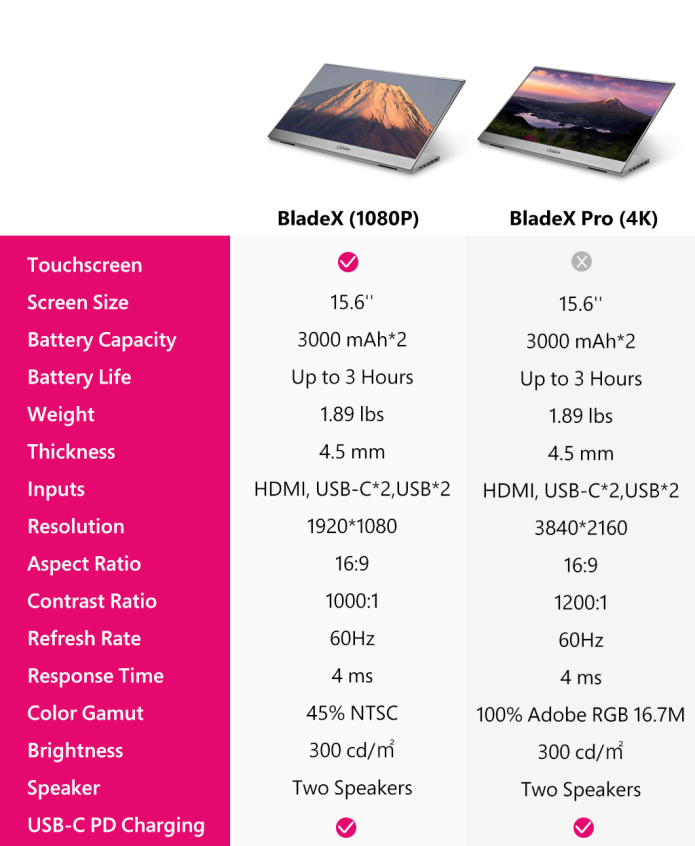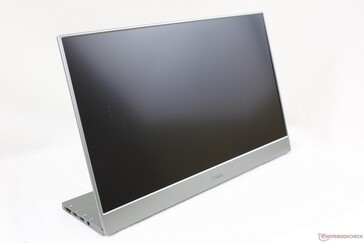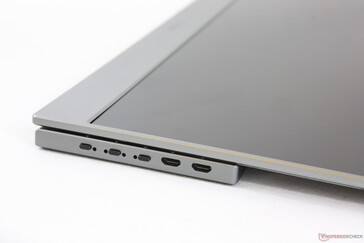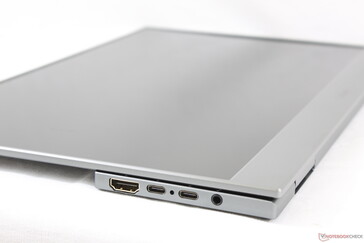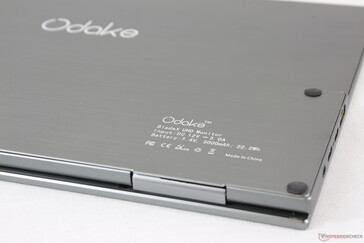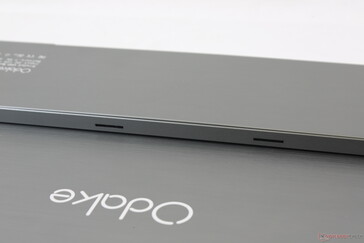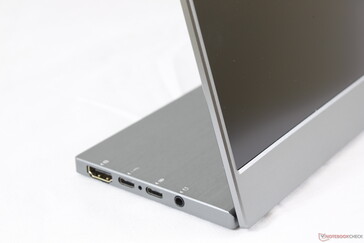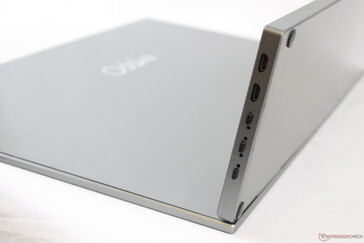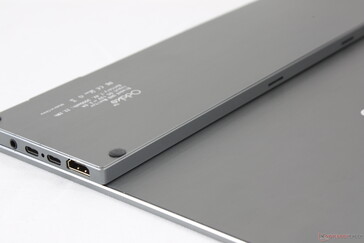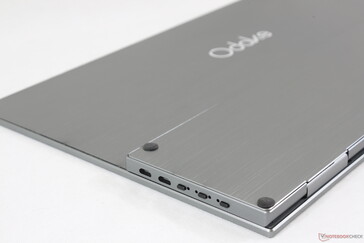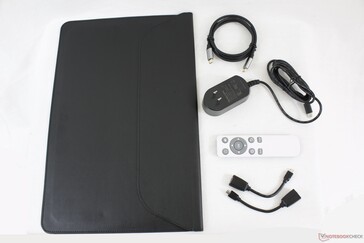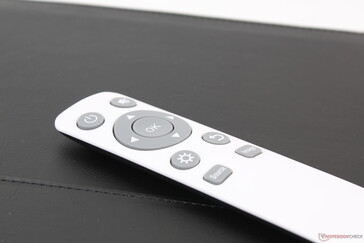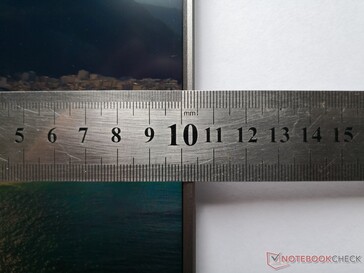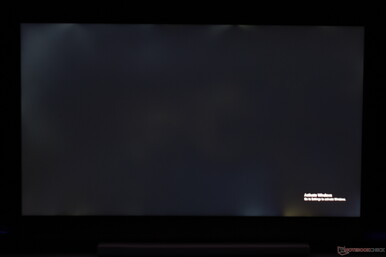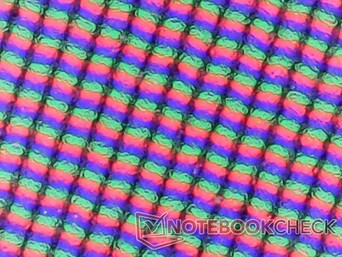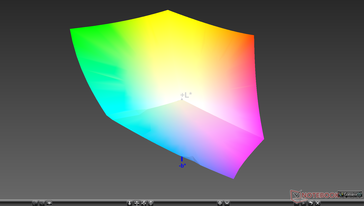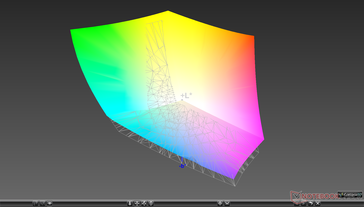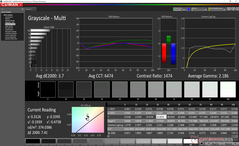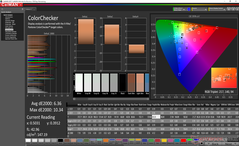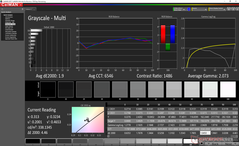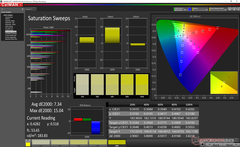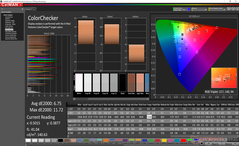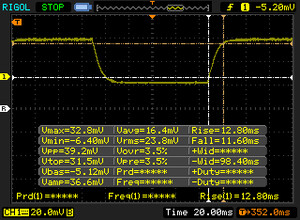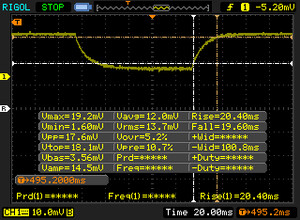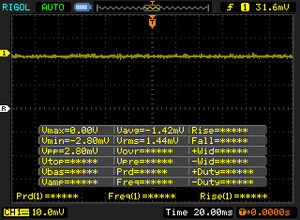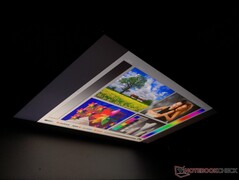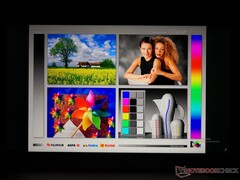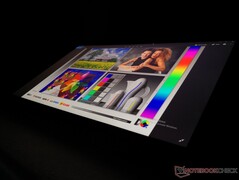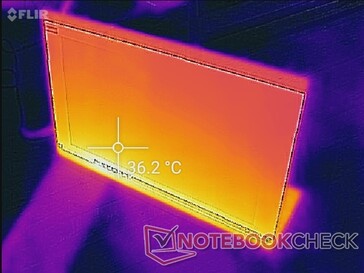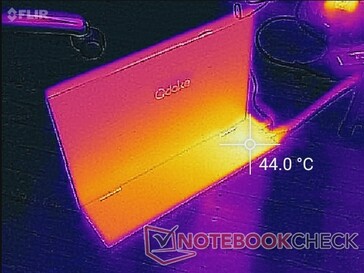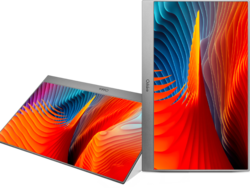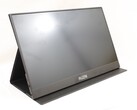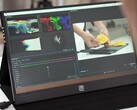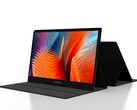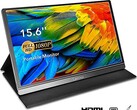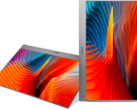A Truly Portable 15-inch Monitor: Odake BladeX Pro 4K UHD Review
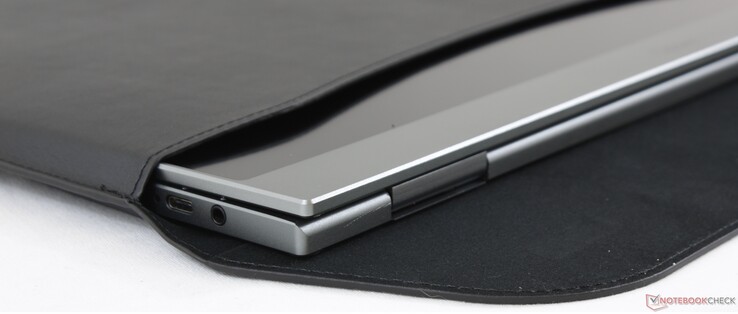
Launched earlier this month as an Indiegogo project, the Odake BladeX is a battery-powered 15.6-inch monitor designed to be taken on-the-go. Its array of ports allows users to connect PCs, Macs, Android phones, gaming consoles, Intel PC sticks, and more to be a jack-of-all-trades display. As of this writing, the project has already passed its initial goal of $20000 USD not four hours after it went live.
Odake plans to launch two main SKUs come November 2019: a 1920 x 1080 FHD touchscreen BladeX model and a 3840 x 2160 4K UHD non-touch BladeX Pro model. Connectivity and chassis features will otherwise be identical between both options. Early bird adopters can pre-purchase the BladeX and BladeX Pro before they launch for $180 and $280, respectively.
The model we have today is a BladeX Pro pre-production unit that should be representative of the final product in terms of performance and impressions. We'll be going over its core features to see if the display can really deliver on all its promises.
See the official product page for the BladeX here and the Indiegogo page here to learn more about the system.
Case
It's obvious that the creators focused heavily on the visual design of the BladeX. It's very thin (~4.5 mm to ~9 mm), lightweight (867 g), and photogenic all at the same time. The narrow bezels further modernize the chassis to be reminiscent of the latest narrow bezel laptops like the Dell XPS 15.
The sleek look, however, comes at a heavy cost. The unit is quite flexible especially around the thin display. This is partly due to the lack of edge-to-edge Gorilla Glass protection, but it's also because of the thin plastic skeleton holding everything together. It's definitely the next step Odake should take to improve its BladeX series even further.
Connectivity
There are more ports options on the BladeX than on many newer Ultrabooks these days. Users have full-size HDMI and four USB ports distributed along the left and right edges to work with. Note that recharging can only be done via one of the USB Type-C ports along the left edge.
Accessories
The box includes a host of extras like a USB Type-C to Type-C cable for video and data, HDMI cable (not shown), 2x Micro-USB to Type-A adapters, a faux leather case, and a small 24 W (12 V, 2 A) USB Type-C AC adapter. Note that this AC adapter can also be used to recharge other USB Type-C devices including smartphones and tablets. If we could ask for one more extra, then a velvet cleaning cloth would be appreciated since the display will inevitably collect smudges over time.
While a remote and battery are also included, our unit would not work no matter what we tried. The screen would not respond to any of our remote inputs.
Display
Much like the high quality visual design of the chassis, the panel itself is also of high quality. The display is reasonably bright at about 360 nits with a high measured contrast of 1200:1. Results are comparable to the displays of many flagship Ultrabooks including the HP Spectre x360 15 in this regard. Response times are average meaning that ghosting will be more noticeable especially if playing fast-paced FPS games. For practically everything else, however, this will not be an issue.
Drawbacks to the visual experience include the slightly grainy matte panel and the moderate uneven backlight bleeding on our unit as shown by our screenshots below. Texts and images are subsequently not as sharp when compared to a glossy display and the backlight bleeding becomes noticeable when viewing videos with black borders. These are generally minor complaints that don't detract from the versatility of the BladeX.
Note that our measurements and comments reflect only the 4K UHD model. The less expensive FHD touchscreen model utilizes a different panel with potentially different black levels, brightness levels, and response times than what we've recorded below.
| |||||||||||||||||||||||||
Brightness Distribution: 88 %
Center on Battery: 371.9 cd/m²
Contrast: 1200:1 (Black: 0.31 cd/m²)
ΔE ColorChecker Calman: 6.36 | ∀{0.5-29.43 Ø4.77}
calibrated: 5.89
ΔE Greyscale Calman: 3.7 | ∀{0.09-98 Ø5}
100% sRGB (Argyll 1.6.3 3D)
91.7% AdobeRGB 1998 (Argyll 1.6.3 3D)
100% AdobeRGB 1998 (Argyll 3D)
100% sRGB (Argyll 3D)
90.5% Display P3 (Argyll 3D)
Gamma: 2.19
CCT: 6474 K
| Odake BladeX 4K UHD 15.6", 3840x2160 | Dell XPS 15 9570 Core i9 UHD LQ156D1, IPS, 15.6", 3840x2160 | HP Spectre x360 15-df0126ng AU Optronics AUO30EB, IPS, 15.6", 3840x2160 | Asus ZenBook 15 UX533FD BOE07D8, IPS, 15.6", 1920x1080 | LG Gram 15Z980-B.AA78B LP156WF9-SPN1, IPS LED, 15.6", 1920x1080 | Apple MacBook Pro 15 2018 (2.6 GHz, 560X) APPA040, IPS, 15.4", 2880x1800 | |
|---|---|---|---|---|---|---|
| Display | -11% | -21% | -24% | -22% | -1% | |
| Display P3 Coverage (%) | 90.5 | 79.6 -12% | 68.1 -25% | 67.2 -26% | 65.3 -28% | 98.7 9% |
| sRGB Coverage (%) | 100 | 98.4 -2% | 94.2 -6% | 88.4 -12% | 96.2 -4% | 99.9 0% |
| AdobeRGB 1998 Coverage (%) | 100 | 79.7 -20% | 68.4 -32% | 64.6 -35% | 66.3 -34% | 86.6 -13% |
| Response Times | -31% | -35% | -33% | 9% | -18% | |
| Response Time Grey 50% / Grey 80% * (ms) | 40 ? | 52.4 ? -31% | 57 ? -43% | 45 ? -13% | 34.3 ? 14% | 43.2 ? -8% |
| Response Time Black / White * (ms) | 24.4 ? | 31.6 ? -30% | 31 ? -27% | 37 ? -52% | 23.7 ? 3% | 31.2 ? -28% |
| PWM Frequency (Hz) | 1000 ? | 117000 ? | ||||
| Screen | -10% | 1% | 0% | 9% | 35% | |
| Brightness middle (cd/m²) | 371.9 | 451.9 22% | 330 -11% | 311 -16% | 349 -6% | 520 40% |
| Brightness (cd/m²) | 366 | 414 13% | 310 -15% | 303 -17% | 331 -10% | 492 34% |
| Brightness Distribution (%) | 88 | 81 -8% | 87 -1% | 81 -8% | 84 -5% | 88 0% |
| Black Level * (cd/m²) | 0.31 | 0.36 -16% | 0.37 -19% | 0.24 23% | 0.32 -3% | 0.39 -26% |
| Contrast (:1) | 1200 | 1255 5% | 892 -26% | 1296 8% | 1091 -9% | 1333 11% |
| Colorchecker dE 2000 * | 6.36 | 5.62 12% | 4.03 37% | 5.1 20% | 3.1 51% | 1.2 81% |
| Colorchecker dE 2000 max. * | 10.34 | 19.1 -85% | 6.74 35% | 8.91 14% | 6.6 36% | 2.3 78% |
| Colorchecker dE 2000 calibrated * | 5.89 | 2.69 54% | 1.96 67% | 2.48 58% | 1.5 75% | |
| Greyscale dE 2000 * | 3.7 | 6.9 -86% | 4.49 -21% | 4.93 -33% | 3.3 11% | 1.3 65% |
| Gamma | 2.19 100% | 2.2 100% | 2.57 86% | 2.44 90% | 2.16 102% | 2.18 101% |
| CCT | 6474 100% | 6254 104% | 6744 96% | 7641 85% | 6973 93% | 6738 96% |
| Color Space (Percent of AdobeRGB 1998) (%) | 91.7 | 71.8 -22% | 61 -33% | 58 -37% | 61.46 -33% | |
| Color Space (Percent of sRGB) (%) | 100 | 98.5 -1% | 94 -6% | 88 -12% | 96.05 -4% | |
| Total Average (Program / Settings) | -17% /
-13% | -18% /
-8% | -19% /
-9% | -1% /
3% | 5% /
19% |
* ... smaller is better
As promised by the manufacturer, color space for the 4K UHD model does indeed cover AdobeRGB almost in its entirety. Color accuracy is average out of the box and additional calibration will be required to make the most out of the wide gamut. Color temperature in particular is slightly warmer than it should be.
Display Response Times
| ↔ Response Time Black to White | ||
|---|---|---|
| 24.4 ms ... rise ↗ and fall ↘ combined | ↗ 12.8 ms rise | |
| ↘ 11.6 ms fall | ||
| The screen shows good response rates in our tests, but may be too slow for competitive gamers. In comparison, all tested devices range from 0.1 (minimum) to 240 (maximum) ms. » 56 % of all devices are better. This means that the measured response time is worse than the average of all tested devices (20.2 ms). | ||
| ↔ Response Time 50% Grey to 80% Grey | ||
| 40 ms ... rise ↗ and fall ↘ combined | ↗ 20.4 ms rise | |
| ↘ 19.6 ms fall | ||
| The screen shows slow response rates in our tests and will be unsatisfactory for gamers. In comparison, all tested devices range from 0.165 (minimum) to 636 (maximum) ms. » 60 % of all devices are better. This means that the measured response time is worse than the average of all tested devices (31.6 ms). | ||
Screen Flickering / PWM (Pulse-Width Modulation)
| Screen flickering / PWM not detected | |||
In comparison: 53 % of all tested devices do not use PWM to dim the display. If PWM was detected, an average of 8091 (minimum: 5 - maximum: 343500) Hz was measured. | |||
Emissions
Temperature
Surface temperatures can be quite warm at almost 45 C on the rear of the unit nearest the HDMI port as shown by our temperature map below. While noticeable when handling the BladeX like a tablet, we don't find the warm temperature to be an issue when the unit is on a desk.
Speakers
Monitors with integrated speakers typically have poor audio quality and the BladeX is no different. Bass is lacking as one would expect even though maximum volume is decently loud. The main problem is that audio becomes increasingly more distorted at higher volume settings which impacts the multimedia experience. Nonetheless, the fact that such a compact and portable monitor can have built-in speakers in the first place is still respectable. A 3.5 mm audio jack is thankfully available.
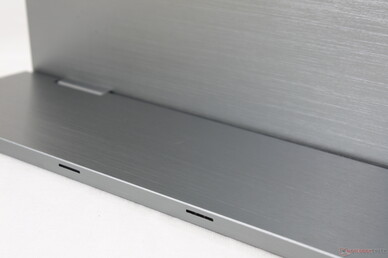
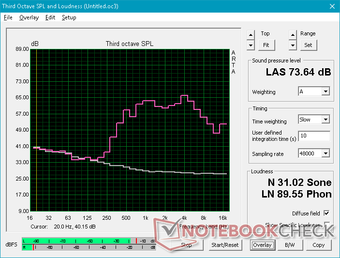
Battery Life
The integrated 22.2 Wh battery allows for only one hour of use when the brightness is set to maximum. Charging from empty to full capacity with the included AC adapter takes over twice as long at about 2.5 hours. Annoyingly, there is no way to know the exact battery percentage; four LED indicators along the edge of the unit only show capacity at 25 percent intervals.
Pros
Cons
Verdict
The versatility of the BladeX is undeniable. We didn't think a 4K UHD 15.6-inch display could ever so be light and portable, but Odake has hit a home run by bringing the concept to life. The integrated battery, speakers, and surprisingly wide port options make this even more impressive for work, play, or travel.
The biggest drawback of the BladeX is its lack of rigidity. There is no edge-to-edge glass on our unit and the chassis skeleton is incredibly thin and flexible. It may look like a tablet, but most tablets are far firmer and tougher than what the BladeX has to offer. It's good that Odake throws in a free faux leather sleeve because you're going to want to keep the BladeX stowed and protected between uses. We're hopeful that a potential BladeX revision in the future would improve the chassis and make the onscreen settings easier to navigate.




